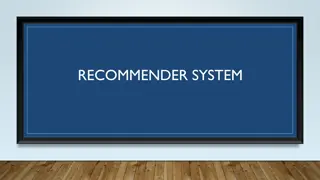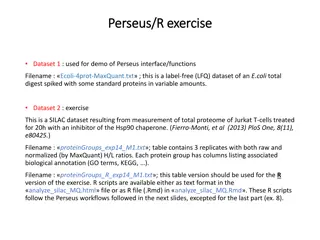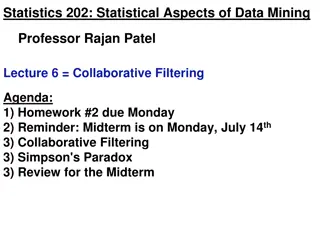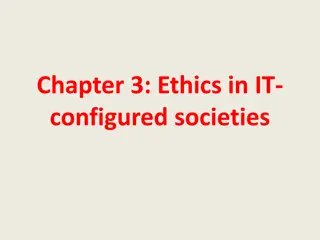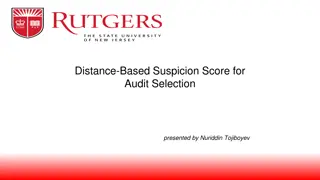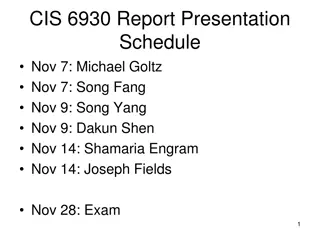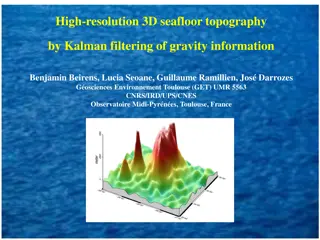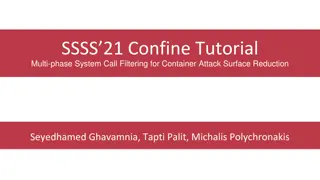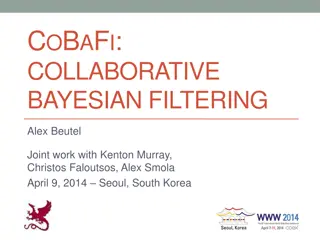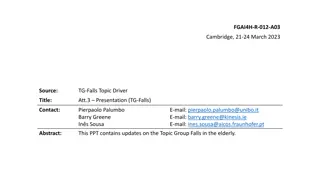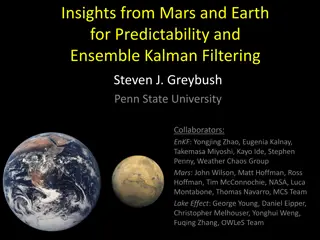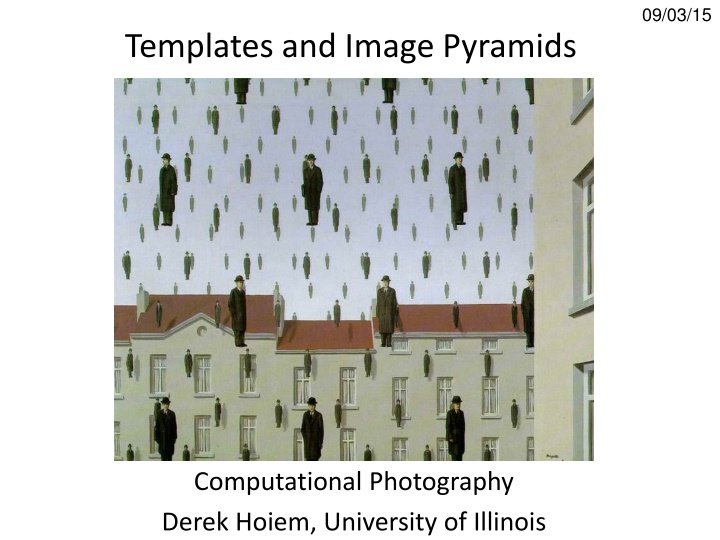
Hybrid Images and Image Processing Techniques
Explore the concepts of hybrid images, template matching, and filtering in image processing. Learn about different interpretations of hybrid images, human perception clues, and applications of filtering techniques in computational photography. Dive into topics like Fourier analysis, FFT, and more to enhance your understanding of image processing methods.
Download Presentation

Please find below an Image/Link to download the presentation.
The content on the website is provided AS IS for your information and personal use only. It may not be sold, licensed, or shared on other websites without obtaining consent from the author. If you encounter any issues during the download, it is possible that the publisher has removed the file from their server.
You are allowed to download the files provided on this website for personal or commercial use, subject to the condition that they are used lawfully. All files are the property of their respective owners.
The content on the website is provided AS IS for your information and personal use only. It may not be sold, licensed, or shared on other websites without obtaining consent from the author.
E N D
Presentation Transcript
09/03/15 Templates and Image Pyramids Computational Photography Derek Hoiem, University of Illinois
Administrative stuff Start working on project 1 (due Sept 14) Make sure you can get a project page up Can now complete first part (hybrid images)
Why do we get different, distance-dependent interpretations of hybrid images? ?
Clues from Human Perception Early processing in humans filters for various orientations and scales of frequency Perceptual cues in the mid frequencies dominate perception When we see an image from far away, we are effectively subsampling it Early Visual Processing: Multi-scale edge and blob filters
Hybrid Image in FFT Hybrid Image Low-passed Image High-passed Image
Perception Why do we get different, distance-dependent interpretations of hybrid images? ?
Things to Remember Sometimes it makes sense to think of images and filtering in the frequency domain Fourier analysis Can be faster to filter using FFT for large images (N logN vs. N2 for auto- correlation) Images are mostly smooth Basis for compression Remember to low-pass before sampling
Review 1. Match the spatial domain image to the Fourier magnitude image 2 3 1 4 5 B C E A D
Todays class: applications of filtering Template matching Coarse-to-fine alignment Denoising, Compression
Template matching Goal: find in image Main challenge: What is a good similarity or distance measure between two patches? Correlation Zero-mean correlation Sum Square Difference Normalized Cross Correlation
Matching with filters Goal: find in image Method 0: filter the image with eye patch , [ ] , [ , l k = + + ] [ , ] h m n g k l f m k n l f = image g = filter What went wrong? Filtered Image Input
Matching with filters Goal: find in image Method 1: filter the image with zero-mean eye ] , [ ( ] , [ , l k = + + ( ) [ , mean of f ) ] l h m n f k l f g m k n True detections False detections Thresholded Image Filtered Image (scaled) Input
Matching with filters Goal: find in image Method 2: SSD ] , [ n m h = + + 2 ( [ , ] [ , ) ] l g k l f m k n , k l True detections Thresholded Image 1- sqrt(SSD) Input
Matching with filters Can SSD be implemented with linear filters? = + + 2 [ , ] ( [ , ] [ , ) ] l h m n g k l f m k n , k l
Matching with filters What s the potential downside of SSD? Goal: find in image Method 2: SSD ] , [ n m h = + + 2 ( [ , ] [ , ) ] l g k l f m k n , k l 1- sqrt(SSD) Input
Matching with filters Goal: find in image Method 3: Normalized cross-correlation mean template mean image patch k + + ( [ , ] )( [ , ] ) g k l g f m k n l f , m n , l = [ , ] h m n 5 . 0 k k + + 2 2 ( [ , ] ) ( [ , ] ) g k l g f m k n l f , m n , , l l Matlab: normxcorr2(template, im)
Matching with filters Goal: find in image Method 3: Normalized cross-correlation True detections Thresholded Image Input Normalized X-Correlation
Matching with filters Goal: find in image Method 3: Normalized cross-correlation True detections Thresholded Image Input Normalized X-Correlation
Q: What is the best method to use? A: Depends Zero-mean filter: fastest but not a great matcher SSD: next fastest, sensitive to overall intensity Normalized cross-correlation: slowest, invariant to local average intensity and contrast
Q: What if we want to find larger or smaller eyes? A: Image Pyramid
Review of Sampling Gaussian Filter Sample Low-Pass Filtered Image Low-Res Image Image
Gaussian pyramid Source: Forsyth
Laplacian filter unit impulse Gaussian Laplacian of Gaussian Source: Lazebnik
Laplacian pyramid Source: Forsyth
Computing Gaussian/Laplacian Pyramid Can we reconstruct the original from the laplacian pyramid? http://sepwww.stanford.edu/~morgan/texturematch/paper_html/node3.html
Hybrid Image in Laplacian Pyramid Extra points for project 1 High frequency Low frequency
Coarse-to-fine Image Registration 1. 2. Compute Gaussian pyramid Align with coarse pyramid Find minimum SSD position Successively align with finer pyramids Search small range (e.g., 5x5) centered around position determined at coarser scale 3. Why is this faster? Are we guaranteed to get the same result?
Question Can you align the images using the FFT?
Compression How is it that a 4MP image can be compressed to a few hundred KB without a noticeable change?
Lossy Image Compression (JPEG) Block-based Discrete Cosine Transform (DCT) Slides: Efros
Using DCT in JPEG The first coefficient B(0,0) is the DC component, the average intensity The top-left coeffs represent low frequencies, the bottom right high frequencies
Image compression using DCT Quantize More coarsely for high frequencies (which also tend to have smaller values) Many quantized high frequency values will be zero Encode Can decode with inverse dct Filter responses Quantization table Quantized values
JPEG Compression Summary 1. Convert image to YCrCb 2. Subsample color by factor of 2 People have bad resolution for color 3. Split into blocks (8x8, typically), subtract 128 4. For each block a. Compute DCT coefficients b. Coarsely quantize Many high frequency components will become zero c. Encode (e.g., with Huffman coding) http://en.wikipedia.org/wiki/YCbCr http://en.wikipedia.org/wiki/JPEG
Lossless compression (PNG) 1. Predict that a pixel s value based on its upper-left neighborhood 2. Store difference of predicted and actual value 3. Pkzip it (DEFLATE algorithm)
Denoising Gaussian Filter Additive Gaussian Noise
Reducing Gaussian noise Smoothing with larger standard deviations suppresses noise, but also blurs the image Source: S. Lazebnik
Reducing salt-and-pepper noise by Gaussian smoothing 3x3 5x5 7x7
Alternative idea: Median filtering A median filter operates over a window by selecting the median intensity in the window Is median filtering linear? Source: K. Grauman
Median filter What advantage does median filtering have over Gaussian filtering? Robustness to outliers Source: K. Grauman
Median filter Median filtered Salt-and-pepper noise MATLAB: medfilt2(image, [h w]) Source: M. Hebert
Median Filtered Examples http://en.wikipedia.org/wiki/File:Medianfilterp.png http://en.wikipedia.org/wiki/File:Median_filter_example.jpg
Median vs. Gaussian filtering 3x3 5x5 7x7 Gaussian Median
Other filter choices Weighted median (pixels further from center count less) Clipped mean (average, ignoring few brightest and darkest pixels) Bilateral filtering (weight by spatial distance and intensity difference) Bilateral filtering Image: http://vision.ai.uiuc.edu/?p=1455
Review of Last 3 Days Filtering in spatial domain Slide filter over image and take dot product at each position Remember linearity (for linear filters) Examples 1D: [-1 0 1], [0 0 0 0 0.5 1 1 1 0.5 0 0 0] 1D: [0.25 0.5 0.25], [0 0 0 0 0.5 1 1 1 0.5 0 0 0] 2D: [1 0 0 ; 0 2 0 ; 0 0 1]/4
Review of Last 3 Days Linear filters for basic processing Edge filter (high-pass) Gaussian filter (low-pass) [-1 1] Gaussian FFT of Gradient Filter FFT of Gaussian
Review of Last 3 Days Derivative of Gaussian
Review of Last 3 Days Filtering in frequency domain Can be faster than filtering in spatial domain (for large filters) Can help understand effect of filter Algorithm: 1. Convert image and filter to fft (fft2 in matlab) 2. Pointwise-multiply ffts 3. Convert result to spatial domain with ifft2
Review of Last 3 Days Applications of filters Template matching (SSD or Normxcorr2) SSD can be done with linear filters, is sensitive to overall intensity Gaussian pyramid Coarse-to-fine search, multi-scale detection Laplacian pyramid Can be used for blending (later) More compact image representation
Review of Last 3 Days Applications of filters Downsampling Need to sufficiently low-pass before downsampling Compression In JPEG, coarsely quantize high frequencies Reducing noise (important for aesthetics and for later processing such as edge detection) Gaussian filter, median filter, bilateral filter
Next class Light and color



